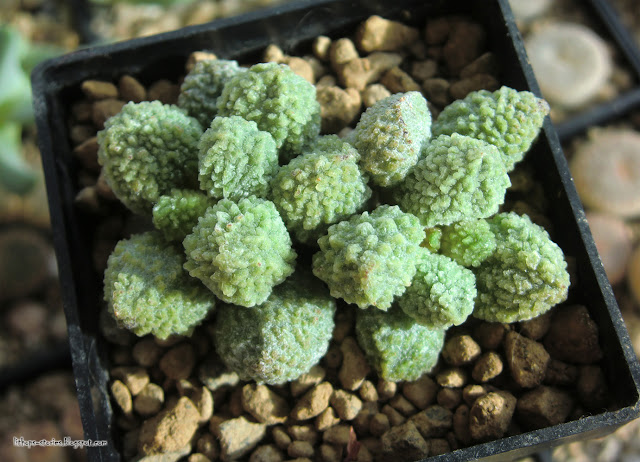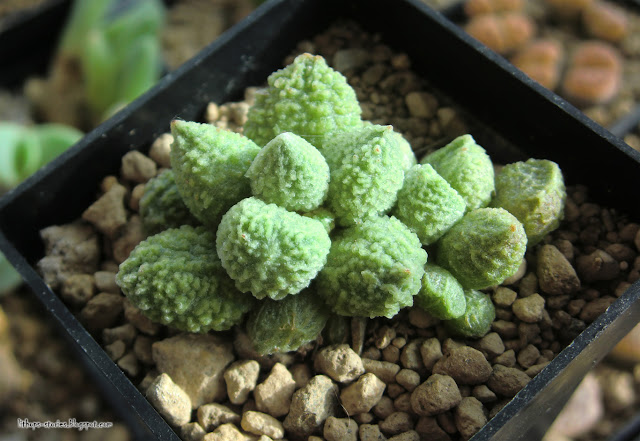I have been growing several Adromischus plants since 2014 but this is the first year I can watch many different types grow and develop. It's exciting and full of discoveries. Having watched them grow for a year or so does not make me an expert but the more I see the better I understand their yearly growing pattern and their needs.
The good news is they are doing very well on a windowsill and in pure pumice substrate! They are definitely not the genus that is "best in a greenhouse", in fact they don't even need that much sunlight. Half a day of it (the sun moves on after 2 pm here) and careful watering will produce compact and healthy plants.
While the red types develop a nice tan with intense sunlight, green types tend to get "bleached", turn lighter green or yellow. Here is my oldest plant. This year it started developing a second branch from below and is overall a nice and healthy one. The next two pictures are of this same plant, taken from two opposite sides. Can you tell which side is the sun-facing side? :D
When the sunlight get less intense the darker green color returns for those types that were supposed to be dark green like the below specimen.
The babies I grew from leaves in the recent years get greener during winter months, too.
But it also means that the "Lime Drops" variety that is actually supposed to be lighter green with pink tips is now also completely green.
And the "herrei" red types turn brownish green, too. The red color will return in the spring.
The new leaves are more intensely colored anyway. The below younger "alveolatus" variety plants have been growing some new red leaves this Fall. So pretty!
Adromischus marianiae "Little Spheroid" are really prone to stretching. I have a plant that stretches in winter every year without fail. And then gets back to looking great by the end of summer.
What I wanted to say is that shape improves with time. No need to fret about it. See the below plant? All the new leaves are narrow and pointy. As the year progresses they will get thick and round thus hiding the stems even better and contributing to the tight shape the plant is supposed to have.
Or, another example. I got these "Droedap" locality plants earlier this year with only two big leaves of an undefinable shape on each. But once they started growing all those perfectly shaped and beautifully colored leaves came out.
The coloring and pattern like the number of dots and spots varies as well. The below Adromischus trigynus barely has any dots on the new leaves. The typical pattern only develops with time as the leaves grow bigger.
There have been lots and lots of flowers, on the new plants as well as plants I've had for years (my pollination attempts have failed though). Most of the leaf cuttings have developed into proper little plants within a year and growing them from seed has turned out to be absolutely possible (although very slow). The only thing that is still standing between you and a windowsill full of Adros is their retail prices. Unfortunately the hype is not yet over. But at least if you have one plant, as it grows, you can create "backup copies" and won't need to spend money again if one of them withers. That's what I've been doing. Because boy I won't be able to re-purchase any of them.
Here are some plants I grew from leaf cuttings this year.
And here are the babies grown from seed that are now 1,5 years old. While it was fun to watch the seedlings grow if you're not as patient, growing Adros from leaf cuttings is the way for you.
I have already written about Adromischus propagation and other observations earlier this year. What I would like to address now is the yearly life cycle of these plants and how to water them.
Watering is actually quite easy. All you need to do is touch and squeeze the leaves a little. If they are soft, you may water. I have actually measured my watering can - one watering is ca. 15 ml tops, 10 ml to be on the safe side. You will notice that the leaves will be really firm the next day. From there you just leave it and water only when the leaves are getting soft again.
There are no periods of time with strict drought as with lithops. A little water all throughout the year is fine if you follow the above rule. The plants mostly rest in winter, not wasting the resources, so automatically you will water less frequently. And even if they continue growing during the winter months it's better to slow them down as much as possible since the lack of sunlight will otherwise cause etiolation. We don't want that. The growing of new leaves happens in spring and in the fall. And they will spend all summer growing inflorescences and flowering. I thought at first that if I don't allow them to flower they would grow more leaves but I now believe they would just sleep instead. So, summer is either for flowering or for resting. Note that the younger leaves increase in size over the course of several months, so if I say they would be resting it means they just won't be pushing new leaves. Existing leaves however will (ideally) continue growing in size to create the typical tight cluster.
Tight growth with hidden stems is also the shape to be maintained and supported. For example, as recent as last month my Adros were actively growing and some still seem to want to continue. However, the days got shorter and I already notice that some try to outgrow the tight shape. Time to reduce or stop watering to avoid stretching. Those succulent leaves have lots of resources to support themselves. And while the new leaves get thicker and rounder the overall "dense foliage" will be maintained.
What I wrote so far sounds quite easy but there are also some issues Adros might have. Like any succulent plants they do rot. The roots are very thick, caudex-like even, and the substrate should be appropriate. I use pure pumice. If you use something else at least in the upper half of the pot it should be just as airy. There is another thing I have seen a couple of times - some sort of white mold at the base of the leaves. No idea what the exact cause is (too damp would be my guess) but if you catch it early and remove the mold and the affected leaves the plant will be fine if kept dry for some time after.
Here are some plants whose proper names I can only guess about.
























So glad to see you update,I'm a novice at platting succulents in China,Qingdao.Thank you for giving us so much useful experience
ReplyDeleteIt's me:D
DeleteGlad I could be of help! :) And thank you very much for visiting.
DeleteI'd like to start again with Adromischus after many years growing and crossing peppers. Could you be interested in swapping adromischus leaves with pepper seeds? 😊
ReplyDelete